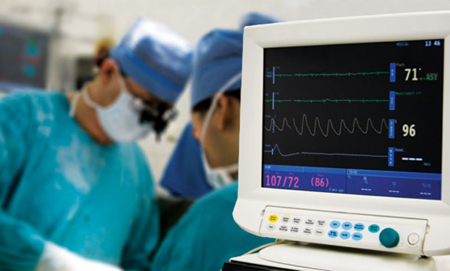Categories
What Is Cardiac Monitor? How Does It Work?

The vast majority of cardiac monitors are electrical devices attached to a patient. The place where electrodes are placed is usually cleaned and shaved thoroughly. In some cases an arm cuff is used as well, when the blood pressure is monitored.
Such monitors provide a visual display of the patient’s parameters. Some of them are set to sound an alarm in case any of the parameters changes outside of the range that is determined by a physician.
There is a whole set of different parameters, including:
- electrocardiogram
- arterial blood oxygen saturation
- cardiac output
- intravascular pressures
- noninvasive blood pressure
- blood temperature
The equipment that is generally required for continuous monitoring includes the cardiac monitor and cables, pressure transducers and electrode patches, arterial blood saturation probes and a pulmonary artery catheter.
Contents
How Is It Implanted?
Implanting a cardiac monitor takes up to 20 minutes, and can be done under a local anesthetic. A physician makes an incision (3/4 of an inch) and creates a pocket of the same shape and size as the monitor. After the device is been inserted, it’s programmed to record the parameters during the fading episode.
Insertable Cardiac Monitor. General Description

An insertable cardiac monitor, or ICM, as it is referred to, is a very small device that is inserted in the upper chest. Its main task is to continuously monitor the heart rhythm, as well as automatically record subcutaneous ECG.
Its use is necessary for:
- Those patients, who experience transient symptoms (dizziness, syncope, chest pain and palpitation that suggest a cardiac arrhythmia).
- The patients with clinical syndromes, as well as situations at the increased risk of cardiac arrhythmias.
The device is referred to as the gold standard in determining causes of unexplained and regular fainting. Many other types of heart monitors are usually attached on the outside for 60 days. This one is created for a long-term use. Generally an insertable cardiac monitor can be used 3 years, increasing the chancing of capturing the heart signal during fainting spells.
Still there are some medical procedures that temporarily affect the ability of the device to collect data. To their number belong the following ones:
- radiation therapy
- electrocautery
- TENS – transcutaneous electrical nerve stimulation
- MRI – magnetic resonance imaging scans
Some of them even require a physician to retrieve the information from the monitor before the procedure. However, this is only up to your physician to decide what to do, because in rare cases, some of the medical procedures done in clinical conditions don’t have a great impact on the abilities of the device.
Implantable Cardiac Monitors. How Does It Work?
As for today, the clinical use of such devices involves the evaluation of symptoms of possible arrhythmic origin (palpitations and unexplained syncope). The ICM is widely used for the most difficult cases of unexplained falls and epilepsy; however the current indications for the application are defined less clearly.
The new generation devices can automatically record arrhythmic episodes, meaning that they can be used to study asymptomatic arrhythmias, as well as for the long-term evaluation of the patients’ total arrhythmic burden, especially of those at risk of arrhythmic events (including symptomatic and asymptomatic).Most modern implantable cardiac monitor are also equipped with a special memory loop. After being activated during the symptoms, it stores a one-lead ECG tracing (prospectively and retrospectively) for a couple of minutes.
The loop memory makes it possible to activate the device even after the symptoms have resolved. ICMs can be widely used even during incapacitating symptoms that normally prevent the activation of other monitoring devices, which don’t have this feature.
Such cardiac monitors are used worldwide. Only your physician can help you to decide whether you need one of them or don’t. In any case, such small devices are highly valued all over the world for their exceptional abilities to control one’s heart rate and blood pressure.



